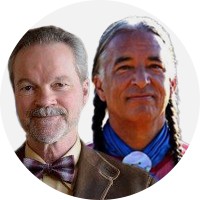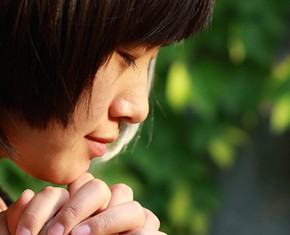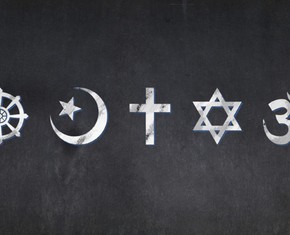The views expressed in our content reflect individual perspectives and do not represent the authoritative views of the Baha'i Faith.
In Kevin Locke’s recent autobiography, Arising, he writes about a “Continental Indigenous Council Fire” that he attended in the summer of 1980 – and that changed his life.
Q: Kevin, you devote an entire chapter of your book Arising to the account of this signal event. Here’s an excerpt from your narrative of that memorable experience:
In the summer of 1980, as I finished my Master’s degree in Community Education and was preparing to start my doctoral studies, a Baha’i friend, Ed Roberts, gave me a call. He was traveling to a gathering at the Baha’i House of Worship for Native American Baha’is and pioneers to the reservations in North America. Over the course of three days, this gathering, the Continental Indigenous Council Fire, would include teaching workshops, prayer, and fellowship. The National Spiritual Assembly of the Baha’is of the United States, as the national administrative body for the Baha’i community, was hosting this gathering. …
One of the most powerful presentations that weekend was by an elder from the Tlingit tribe in Alaska, Eugene King. Eugene was a very tall man, over six feet, and had been blind all of his adult life. His erudite bearing made his presentation incredibly compelling. Eugene had descended from Tlingit Chiefs but had faced ostracization upon becoming a Baha’i and had ultimately sacrificed his chiefdom. Hearing of his sacrifices for our beliefs moved me. Eugene talked about how the Baha’i Faith fulfills both Christian and Indigenous prophetic traditions. He shared long passages from the Baha’i writings and Christian scripture from memory. One of the common strands was how the light of the revelation enables one to see his or her own spiritual heritage and identify the universal aspects that will benefit all of humanity. – Kevin Locke, Arising
In our previous article, Kevin, I asked you about “advance permission” to share the information on Indigenous messengers of God, which has now developed into quite a number of articles. Would you agree that one of the purposes of this Indigenous Messengers of God series is to show “how the light of the revelation enables one to see his or her own spiritual heritage and identify the universal aspects that will benefit all of humanity”?
A: Yes, this is a process that all must go through both individually and collectively as we advance towards an awareness that we all have precious gifts, both as individuals and as a part of one or more of the many of the thousands of diverse kindreds and cultures on our planet – as the Baha’i teachings clearly say:
The progress of the world, the development of nations, the tranquillity of peoples, and the peace of all who dwell on earth are among the principles and ordinances of God. Religion bestoweth upon man the most precious of all gifts, offereth the cup of prosperity, imparteth eternal life, and showereth imperishable benefits upon mankind. – Baha’u’llah, Tablets of Baha’u’llah
This collective process was illustrated powerfully during the 1992 Baha’i World Congress, in New York, when, as requested by the Universal House of Justice, Juan Bejerano spoke about how his Ngöbe (or Ngäbe)-Buglé (Guaymi) people from Panama had used the Revelation of Baha’u’llah as a light to shine upon and illuminate those aspects of their tribal heritage that align with the Divine Standard – and then to develop those qualities in order to present them as a gift to the emerging global civilization. Mr. Bejerano spoke on how his community, inspired by the divine principles, had refined and developed aspects of their music, dance, culture and language with an eye towards enriching all of humanity. He mentioned how the Baha’i revelation had been infused into and enriched the well-being and vitality of every aspect of their identity, as a kindred people, moving into the light of this Day of God.
Q: Interesting! I see that, today, the Ngöbe-Buglé people live in the largest and most populous of Panama’s five Indigenous administrative provinces (comarcas indígenas), in which the Comarca Ngäbe-Buglé was created in 1997 when the Panamanian government finally granted land rights to the Ngöbe-Buglé. (Shouldn’t it have been the other way around, that the invading Europeans should have asked the Ngöbe-Buglé, as the original Indigenous inhabitants of that area, for land rights?) In that region, Baha’i development work has been quite significant, as this present-day example illustrates:
Radio Baha’i in Soloy, Panama, was established in the 1980s to give voice to and serve as an educational and cultural channel for indigenous peoples. The station broadcasts in both Spanish and Ngäbere, the language of the local population, and has at least 7,000 listeners. It produces and airs content especially for children, youth, and women on themes of spiritual import including service, truthfulness, love, and generosity in the form of original songs, skits, announcements, and interviews. – For the Betterment of the World: The Worldwide Baha’i Community’s Approach to Social and Economic Development, Prepared by the Office of Social and Economic Development, Baha’i International Community, p. 36.
So, as an illustrative example, how does “the light of the [Baha’i] revelation enable” you yourself — both as an Indigenous Lakota and and Anishinabe individual and as a spiritually enkindled Baha’i — “to see his or her own spiritual heritage and identify the universal aspects that will benefit all of humanity”?
A: We all pray that God will use us as instruments to serve His greater purpose, and then endeavor to align ourselves with that purpose. I was abundantly blessed, upon becoming a Baha’i, to have doors open in my life that completely transformed and rerouted my life in the direction of developing and using the Indigenous traditional arts to accentuate universal themes. This “rerouting” has enabled outreach to millions of people in nearly 100 countries.
Q: Here, I hear you obliquely referring to your work as “a world-famous visionary Hoop Dancer, preeminent player of the Indigenous Northern Plains flute, traditional storyteller, cultural ambassador, recording artist and educator,” according to one online description of you and your international outreach and renown — and further:
Kevin’s goal is to empower today’s youth in culture and “raise awareness of the Oneness we share as human beings.” His belief in the unity of humankind is expressed dramatically in the traditional Hoop Dance which illustrates “the roles and responsibilities that all human beings have within the hoops (circles) of life,” reflects Kevin. “Through my music and dance, I want to create a positive awareness of the oneness of humanity.” Since 1982, Kevin has recorded twelve albums of music and stories, most recently The First Flute, Open Circle, Keepers of the Dream, and Dream Catcher. Kevin Locke dedicates his life’s work to Baha’u’llah. – KevinLocke.com
So the year 2020 will mark 40 years since that memorable and important “Second Native Baha’i Council of North America” in 1980. Would you encourage another such Continental Indigenous Council Fire to be held in the near future? If so, why?
A: The “Continental Indigenous Councils,” the “Trail of Light” expedition, and many other continental/hemispheric Indigenous activities were initiated by the Baha’i Continental Board of Counselors serving the Western Hemisphere in response to a groundswell of hemisphere-wide interest from Indigenous communities, eager to fulfill prophecies regarding the in-gathering of the widely dispersed and persecuted kindreds from this half of the planet. I personally feel that, as Indigenous communities arise and make a quality response to the forces released through the Revelation of Baha’u’llah, there will be amazing permutations and developments based upon the seeds planted during those original Continental Indigenous Councils.
Q: Kevin, tell me this: from your unique Indigenous-Baha’i perspective, how can Indigenous peoples benefit from the teachings of the Baha’i Faith? How can the world at large benefit from the presence and influence of Indigenous peoples, who are further enlightened and empowered by the teachings of the Baha’i Faith?
A: The brutal legacy of conquest, campaigns of extermination, genocide and oppression on this half of the planet are unmatched in the annals of human history. The negative roles resulting from this half-millennium period of darkness will be made illumined and heroic through the power of God in this new day.
Throughout the Western Hemisphere today, we can hear and acknowledge, with profound respect and admiration, the rising Indigenous voices, speaking dynamically to issues of environmental protection, women’s rights, the education and moral uplift of children, the empowering of youth, the need for equality and equity, and so forth. The power of these strong, inspiring Indigenous voices is rooted in the seeds planted by God through the Indigenous Messengers we have been extolling throughout this series of articles. Those divine voices, filtered through languages and cultures that have appeared, like a beautiful heavenly garden on this land, are now echoing, reverberating and pulsating in hearts throughout the length and breadth of this land, as we speak.
Q: Thanks, Kevin! By the way, this video featuring Indigenous artists, is worth watching:
















Comments
Sign in or create an account
Continue with Googleor